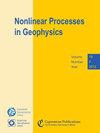Rate-induced tipping in ecosystems and climate: the role of unstable states, basin boundaries and transient dynamics
IF 2.4
4区 地球科学
Q3 GEOSCIENCES, MULTIDISCIPLINARY
引用次数: 2
Abstract
Abstract. The climate system as well as ecosystems might undergo relatively sudden qualitative changes in the dynamics when environmental parameters or external forcings vary due to anthropogenic influences. The study of these qualitative changes, called tipping phenomena, requires the development of new methodological approaches that allow phenomena observed in nature to be modeled, analyzed and predicted, especially concerning the climate crisis and its consequences. Here we briefly review the mechanisms of classical tipping phenomena and investigate rate-dependent tipping phenomena which occur in non-autonomous systems characterized by multiple timescales in more detail. We focus on the mechanism of rate-induced tipping caused by basin boundary crossings. We unravel the mechanism of this transition and analyze, in particular, the role of such basin boundary crossings in non-autonomous systems when a parameter drift induces a saddle-node bifurcation in which new attractors and saddle points emerge, including their basins of attraction. Furthermore, we study the detectability of those bifurcations by monitoring single trajectories in state space and find that depending on the rate of environmental parameter drift, such saddle-node bifurcations might be masked or hidden, and they can only be detected if a critical rate of environmental drift is crossed. This analysis reveals that unstable states of saddle type are the organizing centers of the global dynamics in non-autonomous multistable systems and as such need much more attention in future studies.生态系统和气候中速率诱导的倾斜:不稳定状态、流域边界和瞬态动力学的作用
摘要当环境参数或外部强迫因人为影响而发生变化时,气候系统以及生态系统可能会经历相对突然的动力学质的变化。对这些被称为“引爆现象”的质变的研究,需要发展新的方法方法,使在自然界中观察到的现象能够建模、分析和预测,特别是关于气候危机及其后果的研究。本文简要回顾了经典倾翻现象的机理,并详细研究了发生在多时间尺度非自治系统中的速率相关倾翻现象。本文重点研究了由盆地边界穿越引起的速率诱导翻倒的机理。我们揭示了这种转变的机制,并特别分析了在非自治系统中,当参数漂移引起新的吸引子和鞍点出现的鞍节点分岔时,这种盆地边界交叉的作用,包括它们的吸引盆地。此外,我们通过监测状态空间中的单个轨迹来研究这些分岔的可检测性,并发现依赖于环境参数漂移的速率,这些鞍节点分岔可能被掩盖或隐藏,并且只有当越过临界环境漂移速率时才能被检测到。分析结果表明,鞍型不稳定状态是非自治多稳定系统全局动力学的组织中心,需要在今后的研究中予以重视。
本文章由计算机程序翻译,如有差异,请以英文原文为准。
求助全文
约1分钟内获得全文
求助全文
来源期刊

Nonlinear Processes in Geophysics
地学-地球化学与地球物理
CiteScore
4.00
自引率
0.00%
发文量
21
审稿时长
6-12 weeks
期刊介绍:
Nonlinear Processes in Geophysics (NPG) is an international, inter-/trans-disciplinary, non-profit journal devoted to breaking the deadlocks often faced by standard approaches in Earth and space sciences. It therefore solicits disruptive and innovative concepts and methodologies, as well as original applications of these to address the ubiquitous complexity in geoscience systems, and in interacting social and biological systems. Such systems are nonlinear, with responses strongly non-proportional to perturbations, and show an associated extreme variability across scales.
 求助内容:
求助内容: 应助结果提醒方式:
应助结果提醒方式:


